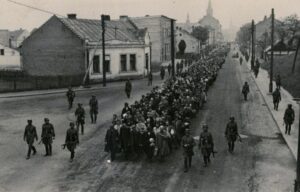
Libertação do campo de concentração de Auschwitz em 27 de janeiro de 1945. (Fotos: Memorial de Auschwitz/Twitter)
Quarta de lembranças, homenagens e silêncio em todo o mundo. Nesta data, em 27 de janeiro de 1945, o Exército Vermelho entrava no campo de concentração de Auschwitz, na Polônia, um dos principais epicentros dos horrores perpetrados pelo nazismo em toda a Europa.
Ao menos, sete mil sobreviventes foram encontrados pelos soviéticos nas instalações. Todos gravemente feridos e doentes, vítimas inocentes das insanidades produzidas por Hitler durante a Segunda Guerra Mundial.
De acordo com a Enciclopédia do Holocausto, do United States Holocaust Memorial Museus (USHMM), apenas no complexo de Auschwitz – que contava com Birkenau, Monowitz e seus subcampos -, cerca de 1 milhão de judeus foram mortos nesses locais.
Ao todo, pesquisas e estudos estimam que 70 a 85 milhões de pessoas pereceram durante a Segunda Guerra, que durou de 1 de setembro de 1939 a 2 de setembro de 1945. A conta oficial do Memorial de Auschwitz, no Twitter, relembra hoje, a quem interessar possa, fotos e fatos da libertação do campo. Ideal para que todos nós nunca nos esqueçamos deste trágico e horrendo período.
Abaixo, alguns tweets compartilhados pelo perfil.
Every day we commemorate the victims & educate about the tragic human history of #Auschwitz.
Follow @AuschwitzMuseum
Please RT if you do.
Support our mission & let people know we are here. pic.twitter.com/3hKYKDvHql— Auschwitz Memorial (@AuschwitzMuseum) January 26, 2021
76 years ago today over 7,000 prisoners of the German Nazi #Auschwitz camp, including some 700 children, were liberated by the soldiers of the Soviet Army. 1,689 days of murder, pain, suffering, and humiliation were over. Today we all remember. We must remember. | #Auschwitz76 pic.twitter.com/63Z0DtshPi
— Auschwitz Memorial (@AuschwitzMuseum) January 27, 2021
For the world #Auschwitz is a symbol of the #Holocaust & crimes of WW2, a painful reminder of what ideologies of hatred may lead humanity to. In 2005 @UN declared 27 January – the date of the liberation of #Auschwitz – as the International #HolocaustRemembranceDay pic.twitter.com/mLxlODRI3w
— Auschwitz Memorial (@AuschwitzMuseum) January 27, 2021
27 January 1921 | A Czech Jewish woman, Růžena Buschová, was born in Prague.
She was deported to #Auschwitz from the #Theresienstadt ghetto on 6 September 1943. She did not survive. pic.twitter.com/23BotwzyD7
— Auschwitz Memorial (@AuschwitzMuseum) January 27, 2021
Read about final days of the operation of the German #Auschwitz camp, tragedy of evacuation, the moment of liberation by the Soviet Army on 27 January 1945, and fate of some 7,500 liberated prisoners in our online lesson full of testimonies of Survivors: https://t.co/hyEaUWEVbu pic.twitter.com/RGxkbLtKNV
— Auschwitz Memorial (@AuschwitzMuseum) January 27, 2021
At Auschwitz we see the end of the long process. It’s important to remember that the Holocaust did not start from gas chambers & murder.
The hatred slowly developed from ideas, words, stereotypes & prejudice, through legal exclusion, escalating violence & dehumanization.
— Auschwitz Memorial (@AuschwitzMuseum) January 27, 2021
The history of #Auschwitz is complex. It combined two functions: a concentration camp and an extermination center. It was used by the Nazi Germans to persecute different groups of people. This online lesson explains the most important aspects: https://t.co/45MCqODtva pic.twitter.com/SdyHyzhRsP
— Auschwitz Memorial (@AuschwitzMuseum) January 27, 2021
27 January 1911 | A Pole, Antoni Weremko, was born in Teratyn.
In #Auschwitz from 13 May 1942.
No. 35341
He was transferred to KL Gross-Rosen and then to KL Sachsenhausen and KL Dachau, where he was liberated. pic.twitter.com/sVCgP1O3jL— Auschwitz Memorial (@AuschwitzMuseum) January 27, 2021
Auschwitz survivors mark the 76th anniversary of liberation of Auschwitz virtually amid pandemic fears https://t.co/25HL6mF2y7
— Auschwitz Memorial (@AuschwitzMuseum) January 27, 2021
Para continuar acompanhando as postagens feitas pelo Memorial, clique AQUI.






Sem comentários